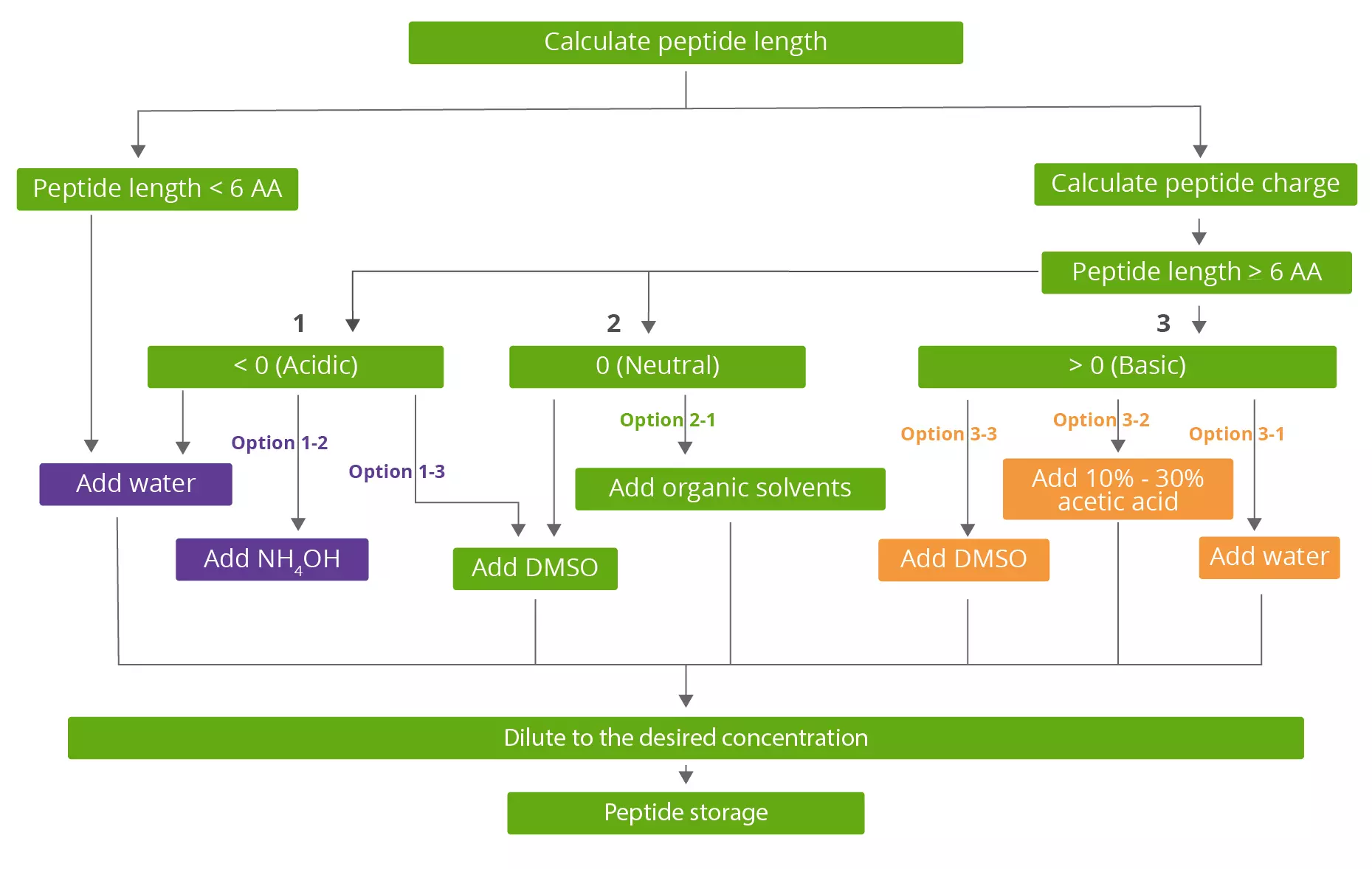You have no items in your shopping cart.
Peptide Solubility Guidelines
Finding the ideal peptide solubility can pose a serious challenge to researchers, since improper solubilization can lead to a loss of peptide or experimental failure.
While many peptides have good solubility in aqueous solutions, others encounter low solubility and insolubility. This is a particular challenge when peptides have long sequences of hydrophobic amino acids. The guide below provides some suggestions to assist in predicting peptide solubility.
Before dissolving your peptide, please read the recommendations below and perform a solubility test.
Generally, peptides should first be dissolved in distilled, sterile water, particularly peptides of fewer than five residues. For individual peptides, conditions are chosen for optimum solubility based on the given peptide sequence.
- Assign a value of -1 to each acidic residue.
- Assign a value of +1 to each basic residue.
- Calculate the overall charge of the peptide.
| Acidic Residues | Basic Residues |
|---|---|
| Asp (D), Glu (E), C-terminal-COOH | Arg (R), Lys (K), His (H) N-terminal-NH2 |
If the overall charge of the peptide is positive, try to dissolve the peptide in water.
- If the peptide cannot be dissolved, try a 10-30% acetic acid solution.
- If the peptide will still not dissolve, use TFA (< 50 μl) to solubilize the peptide and dilute to the required concentration.
If the overall charge of the peptide is negative, try to dissolve the peptide in water.
- If the peptide does not dissolve, add NH4OH (< 50 μl) and dilute to the desired concentration.
- If the peptide contains Cysteine, then do not use basic solutions to dissolve it, use the below method.
If the overall charge of the peptide is zero, try to dissolve the peptide in organic solvents.
- First, use acetonitrile, methanol, or isopropanol.
- For very hydrophobic peptides, try dissolving the peptide in a very small amount of DMSO, and dilute with water to the desired concentration.
- For Cysteine containing peptides use DMF instead of DMSO.
Peptide Dissolving Workflow

Ensure you know the appropriate concentration at which the peptide should be dissolved. Please see this link to a great molarity calculator to help you determine the proper concentration.
Some general guidelines include:
- Peptides shorter than five residues are usually soluble in water or aqueous buffer, except when the entire sequence consists of hydrophobic amino acids.
- For peptides that tend to aggregate, add 6 M guanidine-HCl or 8 M urea, then proceed with the necessary dilutions.
- Hydrophilic peptides containing > 25% charged residues and 25% hydrophobic amino acids are usually soluble in water or aqueous buffers.
- Peptides containing 50% and more hydrophobic residues might be insoluble or only partly soluble in aqueous solutions.
- Warming your solution (< 40°C) may aid in dissolving your peptide.
Please consult literature pertaining to your specific protein as the above are only general guidelines.
Peptide Characteristics
| Peptide Solubility | |
|---|---|
| Hydrophilic | D,E,H,K,Q,R,S,T, hydroxy-proline, pyro-glutamic acid |
| Hydrophobic | A,F,I,L,M,P,V,W,Y, alpha-amino butyric acid, beta-amino alanine, norleucine |
| Peptide Stability | |
| Oxidation in mild conditions | C,M |
| De-amidation, Dehydration, cyclization to pGlu | N, Q, C-terminal residues, N-terminal Q |
| Degradation during preparation | M,W |
| Peptide Charge | |
| Positive | K,R,H, N-terminus |
| Negative | D,E,Y, C-terminus |

